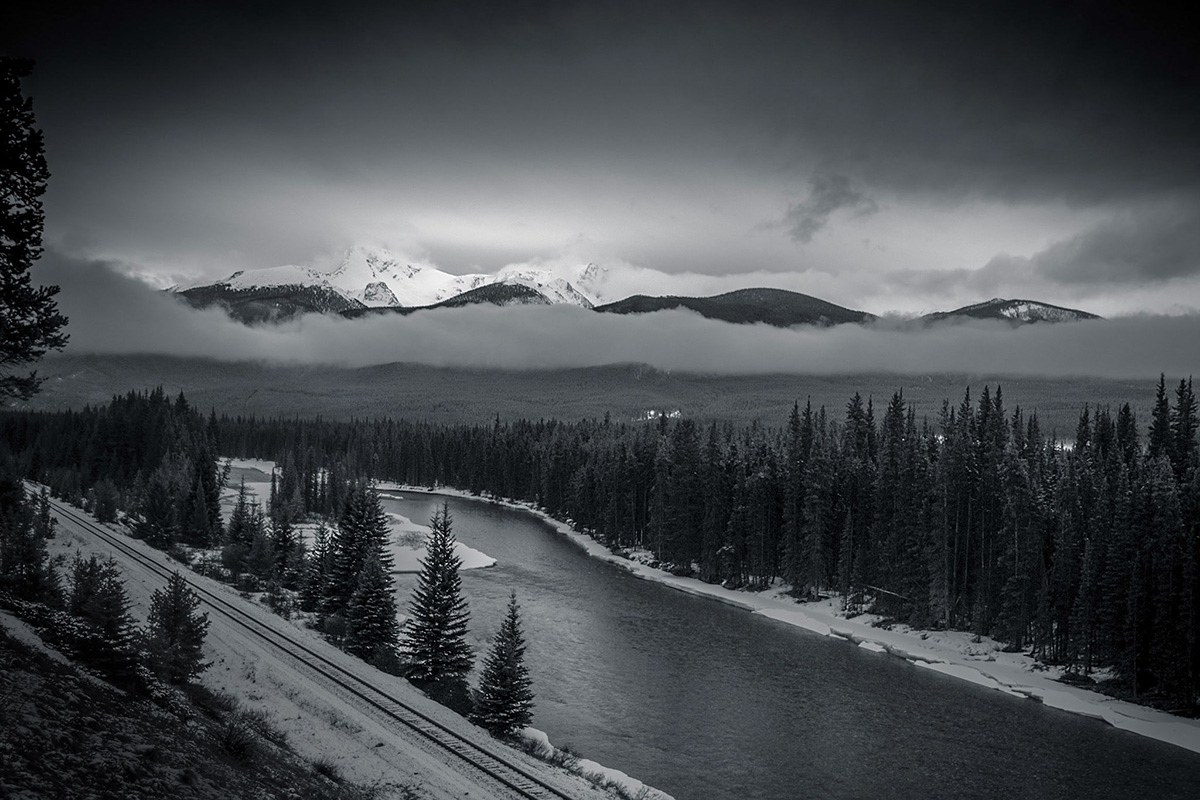Canadian Captures
Kevin Gilligan trekked through Banff National Park with his Tamron SP 70-200mm VC, SP 15-30mm F/2.8 VC Wide-Angle, and 16-300mm VC PZD lenses.
By Jenn Gidman
Images by Kevin Gilligan
For more than a decade, Kevin Gilligan had dreamed of visiting Banff National Park, nestled in the Canadian Rockies just west of Calgary in the province of Alberta. "I'd always seen those wonderful emerald-colored lakes filled with glacier water, surrounded by the jagged snow-capped peaks of the Rockies," he says. "I knew I had to go there at some point to get one of those epic shots of the aqua water with those incredible peaks in the background."
Once Kevin actually made it there in April, however, he had to tweak his plans somewhat, because he and his family were promptly snowed in for four days. "My Southern California kids were cheering in the car, because they were ecstatic for the snow, and we had a great time sledding and skiing while we were there, but I had to rework my photographic strategy," he says. "I decided to concentrate on mostly black and whites so I could emphasize contrasts, since the color I sought was going to be in short supply."
The lenses Kevin brought on his trip to the Great White North included the Tamron SP 70-200mm VC, SP 15-30mm F/2.8 VC Wide-Angle, and 16-300mm VC PZD. "The wide-angle 15-30 was a terrific complement to the two longer lenses, especially in a place like Banff that has such jaw-dropping landscapes," he says.
Lighting in the mountains, and especially in wintry weather, can make or break your photos in Banff. "The thing about shooting in the snow when the clouds are out is that you obviously have cloud cover, which can serve as a giant softbox," Kevin explains. "But when the clouds aren't out, it can be blindingly bright, which makes it hard to get much in the way of contrast and capture a decent shot in the middle of the day. That's why, if it wasn't forecast to be overcast, I'd shoot later in the day or rise early in the morning. It helps that I love that early morning quiet: I'd often get up while everyone was still sleeping and trek out into the snow by myself."
Because the weather was still iffy, some of the areas in the park were off-limits during Kevin's visit, with partial access to others. A popular hike there is one to the Lake Agnes Tea House. "Every day people have to hike up bearing food and drink to the tea house, because there's no other way to get it there—there's no road leading up," Kevin explains. "In milder weather, you can punctuate your hike with a visit to the tea house, where you can enjoy some tea and crumpets or other refreshments."
However, the tea house is closed during the winter and it hadn't reopened for the season during Kevin's stay. "We hiked to the teahouse, though we couldn't go past that because of avalanche dangers," he says. "The path was a snowy, quiet one—if you're familiar with snow, you know just the kind of quiet I mean when snow is falling. It's a special sound."
Kevin captured an early morning photo of the snow-swept peaks from the hiking trail. "I was up there for about an hour, taking different photos and thinking about composition," he says. "I had to be somewhat careful, because there was a lake right in front of us, in various stages of being frozen. You can't see much because of the snow, so it can be treacherous. I loved the mood of this photo. In post-production I cooled the tones down further and brought out more of the clouds. You'll also notice the little animal tracks in the snow in front of me. We didn't see much wildlife while we were up there, because the animals were likely still holed up for the winter, so this was the only apparent sign of the local residents."
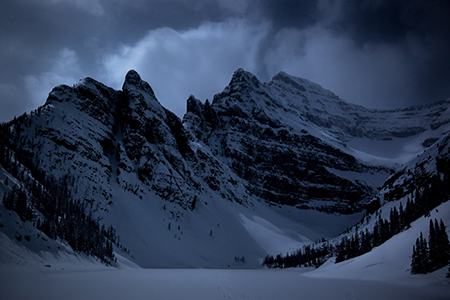
15-30 (23mm), F/13, 30 sec., ISO 200, with a 10-stop ND filter
For two black-and-white photos he captured while leaving Lake Louise, Kevin was glad to have his 16-300. "It's perfect for hiking, like I was doing in these two images, because it's light, versatile, and sharp—I achieve such crisp photos with this lens," he says.
There are two alternate routes just off of the Trans-Canada Highway that one can take when leaving Lake Louise and heading toward Banff proper: Highway 1 or Highway 1A, also known as the Bow Valley Parkway. "I recommend 1A for a more scenic drive," Kevin says. It was along this path that he came across Morant's Curve, a famous section of train track named for photographer Nicholas Morant, who used to take pictures in the mid-1900s of the Canadian Pacific Railway trains passing through the region.
"The train does actually still run through here," Kevin says. "For this first image, I really loved the lines of the tracks, as well as the natural lines of the landscape: high on the left, then lower in the center, then the lines in the background. There's a lot of eye-catching intersection going on here."
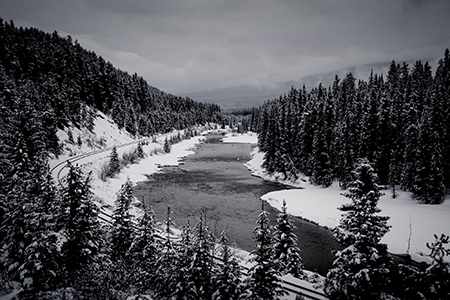
16-300 (44mm), F/7.1, 1/160th sec., ISO 320
For a second shot, Kevin stopped his drive to hike down about 100 feet for a slightly different perspective. "For me, it was all about the light and the layers in this photo," he says. "First you see that darker row of clouds, then the dark mountains, then a lighter row of clouds and light streaming through the clouds and touching the tops of the peaks. It was just gorgeous. It's the kind of light that makes you stop and get out of your car to capture the scene."
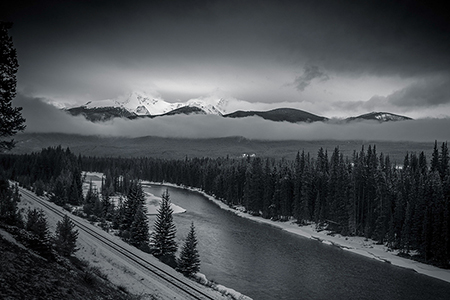
16-300 (18mm), F/7.0, 1/125th sec., ISO 250
Playing with light and shadow also served Kevin well on his snowbound sojourn. "I loved the way the natural lines of the two mountains converge to make that appealing V-shape," he says of his next photo. "I took this photo at around 10 in the morning, and it was fascinating to watch because the clouds were changing so rapidly, going from light to dark. I wanted to capture the contrast between the white snow, the shadows, and the light on the snowy mountaintops. This image is a 30-second exposure, and the wispier clouds provide a nice contrast while still keeping the highlights on the snowy peaks."

15-30mm (15mm), F/9, 30 sec., ISO 500
Not that Kevin didn't track down any color on his treks. "I came across this magnificent frozen waterfall in Lake Louise," he says. "There are people who actually ice-hike up the waterfall, and when I was hiking by myself just after sunrise one morning, I met a guy who was actually a Nepalese hiker and Sherpa. He had a pickaxe and crampons and everything! When I asked him why he was in Lake Louise, he said, 'I came here to practice my climbing on the ice waterfalls.'"
Kevin waited for a couple of other hikers to enter the frame so he could incorporate a sense of scale into the image. "It's hard to get a sense of how grand it all is, even how big those trees are in that forest," he says. Because the water was already a fairly brilliant blue, he edited the image just a bit in post-production to bring out the colors he coveted. "I may not have captured as many of these types of photos as I'd originally planned, but I'm glad to at least get this one," he says.
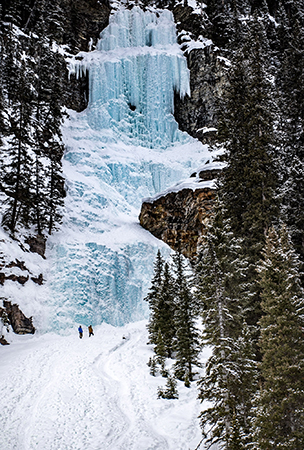
16-300 (57mm), F/5, 1/100th sec., ISO 200
To see more of Kevin Gilligan's work, go to www.photosbykag.com.
